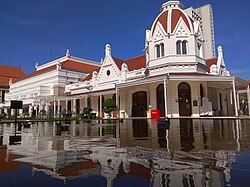| The article's lead section may need to be rewritten. Please help improve the lead and read the lead layout guide. (August 2024) (Learn how and when to remove this message) |
| Balai Pemuda | |
|---|---|
 Balai Pemuda in 2020 Balai Pemuda in 2020 | |
| Former names | Simpangsche Societeit or Simpangsche Club |
| General information | |
| Architectural style | New Indies Style, Dutch Rationalism, Neo Renaissance |
| Address | Jalan Suryo No.15, Surabaya, Indonesia |
| Coordinates | 7°15′50″S 112°44′43″E / 7.2639219°S 112.74529300566195°E / -7.2639219; 112.74529300566195 |
| Completed | 1907 |
| Owner | Surabaya City Government |
| Design and construction | |
| Architect(s) | J.J van der Mey |
Balai Pemuda or Alun-Alun Surabaya is a rich historical site in Surabaya. The site serves as a hub for cultural and artistic activities.
History
Originally built in 1907, it was known as Simpangsche Societeit or Simpangsche Club a nightlife venue for European elites, especially Dutch citizens. The locals affectionately called it “Roemah Kamar Bola” due to the billiards game held there. Designed by Dutch architect Westmaes, this heritage building features a distinctive dome resembling a crown. Today, Balai Pemuda hosts art events, houses the Surabaya Public Library, and includes Alun-alun Surabaya—an outdoor area with a food court and exhibition space12.
During the colonial era, Simpangsche Societeit served as an exclusive club where parties, informal meetings, dances, and other elite entertainment took place. It symbolized Western culture’s influence and the dominance of the colonial government. However, after Indonesia gained independence, Balai Pemuda transformed its purpose. It became a hub for youth activities, focusing on education, arts, and culture. Today, it continues to thrive as a cultural center, promoting heritage preservation and community engagement.
See also
Reference
- "Balai Pemuda dan Alun-alun Surabaya". tourism.surabaya.go.id (in Indonesian). 26 October 2021. Retrieved 1 December 2023.
- Prakoso, Rayhan Aulia (22 June 2023). "Balai Pemuda Surabaya: Spot Wisata Sejarah yang Kekinian". kotomono.co (in Indonesian). Retrieved 11 August 2023.
- Alfian, Fahmi (3 October 2021). "Sejarah Balai Pemuda: Perubahan fungsi dari Tempat Kaum Elit Belanda menjadi Bangunan Cagar Budaya". surabayaonline.co (in Indonesian). Retrieved 7 September 2023.
- Operator, Admin (22 April 2023). "Balai Pemuda". holidify.com. Retrieved 11 October 2022.
This article about a building or structure in Indonesia is a stub. You can help Misplaced Pages by expanding it. |